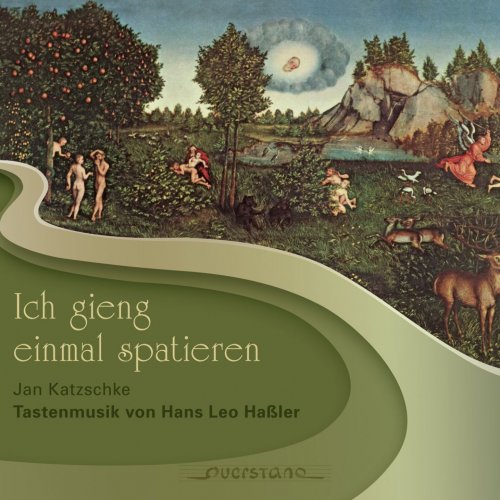
Jan Katzschke - Ich gieng einmal spatieren (Tastenmusik von Hans Leo Hassler) (2015)
BAND/ARTIST: Jan Katzschke
- Title: Ich gieng einmal spatieren (Tastenmusik von Hans Leo Hassler)
- Year Of Release: 2015
- Label: Querstand
- Genre: Classical Harpsichord
- Quality: flac lossless (tracks) +Booklet
- Total Time: 00:59:35
- Total Size: 345 mb
- WebSite: Album Preview
Tracklist
01. Ich gieng einmal spatieren
02. Canzon in D Minor
03. Ricercar del secondo tono
04. Magnificat quarti toni: No. 1, Magnificat
05. Magnificat quarti toni: No. 2, Et exsultavit (Hassler Versus No. 1)
06. Magnificat quarti toni: No. 3, Quia respexit
07. Magnificat quarti toni: No. 4, Quia fecit (Hassler Versus No. 2)
08. Magnificat quarti toni: No. 5, Et misericordia
09. Magnificat quarti toni: No. 6, Fecit potentiam (Hassler Versus 3)
10. Magnificat quarti toni: No. 7, Deposuit
11. Magnificat quarti toni: No. 8, Esurientes (Hassler Versus No. 4)
12. Magnificat quarti toni: No. 9, Suscepit Isarael
13. Magnificat quarti toni: No. 19, Sicut locutus (Hassler Versus No. 5)
14. Magnificat quarti toni: No. 10, Gloria Patri
15. Magnificat quarti toni: No. 11, Sicut erat...Amen (Hassler Versus No. 6)
Born in 1564 in Nuremberg as the second son of a “stonecutter” and organist from Bohemia, Hans Leo Haßler initially got his education from his father, than later from Leonhard Lechner. In 1584-85 he studied as one of the first German musicians in Italy: he discovered the latest musical styles of the time in Venice with Andrea Gabrieli. He quickly advanced in life to become arguably the most important composer of the late Renaissance; his masses, motets and secular choral works set the benchmark and are still today considered in part to be included in the “canon” of choral literature.
Without question, the 31 variations on the song “Ich gieng einmal spatieren” [“I once went walking”] can be considered to be Haßler's most important works for keyboard instruments. Their technical demands, but above all their methodically thought out conceptualisation and monumental length are testament to Haßler's extraordinary abilities. This masterful conceptualisation, invested in the cohesion of the overall form, and the complex compositional and emotional profundity mark a high point for keyboard arts in 1600 to the north of the Alps, an equivalent to Bach's Goldberg Variations and Beethoven's Diabelli Variations in size and importance. On his second CD for querstand label, Jan Katzschke combines this peak work with three other Haßler compositions which demonstrate his Italian influences as well as his versatility. The Magnificat – a typical part of liturgy in the times around 1600 – features Katzschke as vocalist, too.
01. Ich gieng einmal spatieren
02. Canzon in D Minor
03. Ricercar del secondo tono
04. Magnificat quarti toni: No. 1, Magnificat
05. Magnificat quarti toni: No. 2, Et exsultavit (Hassler Versus No. 1)
06. Magnificat quarti toni: No. 3, Quia respexit
07. Magnificat quarti toni: No. 4, Quia fecit (Hassler Versus No. 2)
08. Magnificat quarti toni: No. 5, Et misericordia
09. Magnificat quarti toni: No. 6, Fecit potentiam (Hassler Versus 3)
10. Magnificat quarti toni: No. 7, Deposuit
11. Magnificat quarti toni: No. 8, Esurientes (Hassler Versus No. 4)
12. Magnificat quarti toni: No. 9, Suscepit Isarael
13. Magnificat quarti toni: No. 19, Sicut locutus (Hassler Versus No. 5)
14. Magnificat quarti toni: No. 10, Gloria Patri
15. Magnificat quarti toni: No. 11, Sicut erat...Amen (Hassler Versus No. 6)
Born in 1564 in Nuremberg as the second son of a “stonecutter” and organist from Bohemia, Hans Leo Haßler initially got his education from his father, than later from Leonhard Lechner. In 1584-85 he studied as one of the first German musicians in Italy: he discovered the latest musical styles of the time in Venice with Andrea Gabrieli. He quickly advanced in life to become arguably the most important composer of the late Renaissance; his masses, motets and secular choral works set the benchmark and are still today considered in part to be included in the “canon” of choral literature.
Without question, the 31 variations on the song “Ich gieng einmal spatieren” [“I once went walking”] can be considered to be Haßler's most important works for keyboard instruments. Their technical demands, but above all their methodically thought out conceptualisation and monumental length are testament to Haßler's extraordinary abilities. This masterful conceptualisation, invested in the cohesion of the overall form, and the complex compositional and emotional profundity mark a high point for keyboard arts in 1600 to the north of the Alps, an equivalent to Bach's Goldberg Variations and Beethoven's Diabelli Variations in size and importance. On his second CD for querstand label, Jan Katzschke combines this peak work with three other Haßler compositions which demonstrate his Italian influences as well as his versatility. The Magnificat – a typical part of liturgy in the times around 1600 – features Katzschke as vocalist, too.
As a ISRA.CLOUD's PREMIUM member you will have the following benefits:
- Unlimited high speed downloads
- Download directly without waiting time
- Unlimited parallel downloads
- Support for download accelerators
- No advertising
- Resume broken downloads


